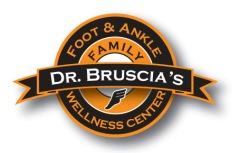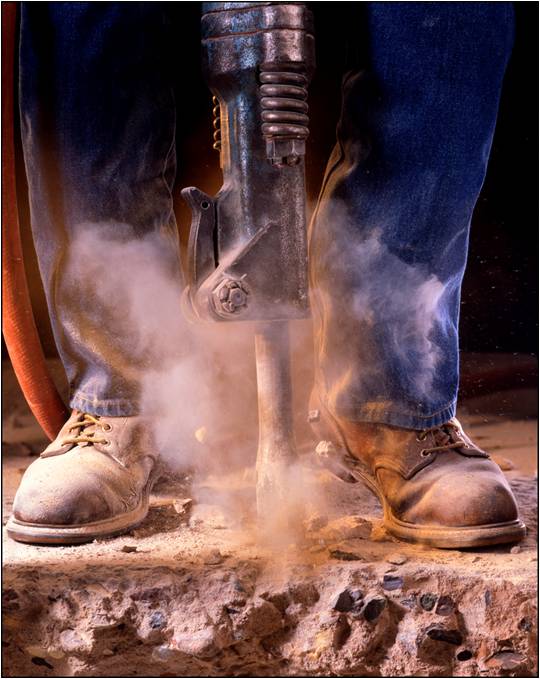
On The Job Foot Health
Your ability to use your feet safely, with ease and comfort, is vital if you are to remain a valuable and productive worker. When your job requires you to walk significant distances, stand on your feet for long periods, work in potentially hazardous areas or with potentially hazardous materials, you have some risk of foot injury. However, you can do a lot to prevent injuries by keeping your feet healthy and following safe work practices. In 1994, there were about 140,000 job-related foot injuries, 40,000 of them toe injuries, according to the National Safety Council. And those were only the reported incidents; experts say many injuries go unreported. You can't take your feet for granted. And your concern for them cannot be divided; it should continue off the job, as well as at work.
On The Job
It is important for you to develop safe work habits and attitudes. Some things to remember:
- Be aware of the hazards of your job and the proper protective measures to take.
- Don't take chances or unnecessary risks. Take time to do your job right.
- Be alert. Watch for hidden hazards.
- Be considerate. Watch out for other workers' safety.
- Follow the rules. Don't cut corners. Use your equipment as specified.
- Concentrate on the job. Inattention can lead to accidents.
- Pace yourself. Work steadily at a comfortable speed.
- Keep your work area clean and your tools in their place.
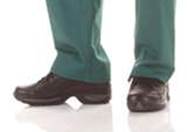
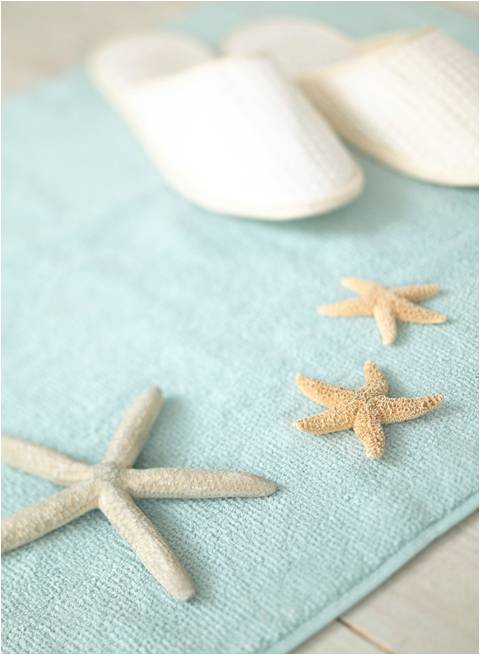
Off The Job
There are a few simple things you should do:
- Bathe your feet daily; dry them thoroughly.
- Check your feet frequently for any changes – redness, swelling, growths, skin changes (e.g., corns, calluses, cracks).
- Keep your feet warm in winter, cool in summer.
- Trim your toenails straight across, slightly longer than the end of the toe.
- Prevent foot problems by visiting your podiatrist as part of your annual health check-up
- Wear protective footwear when using lawnmowers or chain-saws, moving heavy objects, working around chemicals, or in extreme temperatures.
Protective Footwear Is Essential
Safety shoes and boots protect your feet, help prevent injuries to them, and reduce the severity of injuries that do occur in the workplace. Only one out of four victims of job-related foot injury wear any type of safety shoe or boot, according to the National Safety Council. The remaining three either are unaware of the benefits of protective footwear or complain about it. Safety footwear can be comfortable, flexible, stylish, and still provide protection from injury. The foot is a most valuable part of your body subjected to injury in industry. Because of the many potential work hazards, it is important that you discuss with your supervisor the safety shoe, boot, or other protective equipment that you need for your protection.
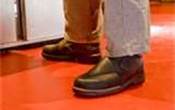
Avoiding Potential On-the-Job Hazards
- HAZARD: falling
and rolling objects, cuts and punctures
PROTECTION: steel-toe safety shoes; add-on devices: metatarsal guards, metal foot guards, puncture-proof inserts, shin guards
- HAZARD:
chemicals, solvents
PROTECTION: footwear with synthetic stitching, and made of rubber, vinyl or plastic
- HAZARD:
electric current
PROTECTION: shoes or boots with rubber soles, and heels, no metal parts and insulated steel toes
- HAZARD: extreme
cold
PROTECTlON: shoes or boots with moisture- or oil-resistant insulation, and that can repel water (if this is a problem); insulated socks
- HAZARD: extreme
heat and direct flame
PROTECTION: overshoes or boots of fire-resistant materials with wooden soles
- HAZARD: high
voltage
PROTECTION: shoes with rubber or cork heels and soles, and no exposed metal parts
- HAZARD: hot
surfaces
PROTECTION: safety shoes with wooden or other heat-resistant soles; wooden sandals over shoes
- HAZARD:
sanitation contamination
PROTECTION: special plastic booties or overshoes; paper or wood shower sandals
- HAZARD: slips
and skids wet, oily surfaces)
PROTECTION: shoes with wooden soles or cleated, non-slip rubber or neoprene soles; non-skid sandals that slip over shoes; strap-on cleats for icy surfaces
- HAZARD sparking (from
metal shoe parts)
PROTECTION: safety shoes with no metal parts and non-sparking material
- HAZARD: sparks,
molten metal splashes (that get inside shoes)
PROTECTION: foundry boots with elastic sides or quick-release buckles for speedy removal
- HAZARD: static
electricity
PROTECTION: shoes or boots with heels and soles of cork or leather
- HAZARD:
wetness
PROTECTION: lined rubber shoes or boots; rubbers or shoes of silicone-treated leather
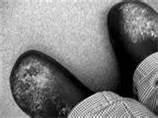
If Your Feet Are Injured At Work
Report any injury to your foreman or supervisor promptly for necessary first aid. Then see Dr. Bruscia if further treatment is recommended. Foot pain is not normal, though many people try to bear up under it, under the mistaken notion that feet are supposed to hurt And proper foot are improves your efficiency and keeps you on the job. Dr. Bruscia is a specialist who diagnoses and treats foot disorders and injuries medically and surgically. By visiting him or her regularly, you an insure yourself a lifetime of pain-free feet.
Heel Pain
In our pursuit of healthy bodies, pain can be an enemy. In some instances, however, it is of biological benefit. Pain that occurs right after an injury or early in an illness may play a protective role, often warning us about the damage we've suffered. When we sprain an ankle, for example, the pain warns us that the ligament and soft tissues may be frayed and bruised, and that further activity may cause additional injury. Pain, such as may occur in our heels, also alerts us to seek medical attention. This alert is of utmost importance because of the many afflictions that contribute to heel pain.
Heel pain is generally the result of faulty biomechanics (walking gait abnormalities) which place too much stress on the heel bone and the soft tissues that attach to it. The stress may also result from injury, or a bruise incurred while walking, running, or jumping on hard surfaces; wearing poorly constructed footwear; or being overweight. The heel bone is the largest of 26 bones in the human foot, which also has 33 joints and a network of more than 100 tendons, muscles, and ligaments. Like all bones, it is subject to outside influences that can affect its integrity and its ability to keep us on our feet. Heel pain, sometimes disabling, can occur in the front, back, or bottom of the heel.
Heel Spurs
A common cause of heel pain is the heel spur, a bony growth on the underside, forepart of the heel bone. The spur, visible by X-ray, appears as a protrusion that can extend forward as much as half an inch. When there is no indication of bone enlargement, the condition is sometimes referred to as “heel spur syndrome." Heel spurs result from strain on the muscles of the foot, by stretching of the long band of tissue that connects the heel and the ball of the foot, and by repeated tearing away of the lining or membrane that covers the heel bone. These conditions may result from biomechanical imbalance, running or jogging, improperly fitted or excessively worn shoes, or obesity.
Plantar Fasciitis
Both heel pain and heel spurs are frequently associated with an inflammation of the band of fibrous connective tissue (fascia} running along the bottom (plantar surface) of the foot, from the heel to the ball of the foot. The inflammation is called plantar fasciitis. It is common among athletes who run and jump a lot, and can be quite painful. The condition occurs when the plantar fascia flattens out and elongates over time beyond its normal extension, causing the soft tissue fibers of the fascia to tear or stretch at various points along its length, including at the heel bone A gap occurs, which between the fascia and the heel bone may be filled in with the growth of new bone. The inflammation may be aggravated by shoes that lack appropriate support, especially in the arch area, and by the chronic irritation that sometimes accompanies an athletic lifestyle. Resting provides only temporary relief. When you resume walking, particularly after a night's sleep, you may experience a sudden elongation of the fascia band which stretches and pulls on the heel. As you walk, the heel pain may lessen or even disappear, but that may be just a false sense of relief. The pain often returns after prolonged rest.
Excessive Pronation
Heel pain sometimes results from excessive pronation. Pronation is the normal flexible motion of the foot that allows it to adapt to ground surfaces and absorb shock in the normal walking pattern. As you walk, the heel contacts the ground first; the weight shifts first to the outside of the foot, then moves toward the big toe. The arch rises, the foot generally rolls upward and outward, becoming rigid and stable in order to lift the body and move it forward. Excessive pronation – excessive inward motion – can create an abnormal amount of stretching and pulling on the fascia while jogging or running, for example. Excessive pronation may also contribute to injury to the hip, knee, and lower back.
Disease and Heel Pain
Some general health conditions can also bring about heel pain. Rheumatoid arthritis and other forms of arthritis, including gout, which usually manifests itself in the big toe joint, can cause heel discomfort in some cases. Heel pain may also be the result of an inflamed bursa (bursitis), a small, irritated sack of fluid; a neuroma (a nerve growth); or another soft-tissue growth. Such heel pain may be associated with a heel spur, or may mimic the pain of a heel spur. Haglund's deformity ("pump bump"} is a bone enlargement at the back of the heel bone, in the area where the Achilles tendon attaches to the bone. This sometimes painful deformity generally is the result of bursitis caused by pressure against the shoe, and can be aggravated by the height or stitching of a heel counter of a particular shoe, Bone bruises, and stone bruises, are common heel injuries. A bone bruise or contusion is an inflammation of the skin that covers the heel bone. A stone bruise is a sharply painful injury caused by the direct impact of a hard object or surface on the foot. Stress fractures can occur, but these are less frequent.
Prevention
A variety of steps can be taken to avoid heel pain and accompanying afflictions:
- Wear shoes that fit well – front, back, and sides – and have shock-absorbent soles, rigid shanks, and supportive heel counters.
- Wear the proper shoes for each activity.
- Do not wear shoes with excessive wear on heels or soles.
- Prepare properly before exercising. Warm up before running or walking, and do some stretching exercises afterward.
- Pace yourself when you participate in athletic activities.
- Don't underestimate your body's need for rest and good nutrition.
- If obese, lose weight.
